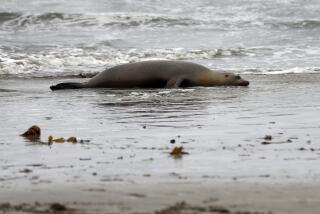Green Crabs Clawing Through Shellfish Along the West Coast
- Share via
SEATTLE — A small but tough predator with an insatiable appetite for shellfish is making its way north along the West Coast, with a potentially devastating impact on shellfish growers.
The green shore crab (also known as Carcinus maenas) has spawned concern among shellfish growers as it travels up the coast. West Coast sightings began in 1989 in the San Francisco Bay, moved north in 1993 to California’s Tomales Bay, then on to California’s Humbolt Bay in 1995, and finally appeared in Coos Bay, Ore., in March.
This fist-sized crustacean, native to Europe, may appear harmless, but looks can be deceiving.
Between the 1930s and 1940s the green crabs invaded the East Coast, resulting in the dramatic decline of bivalves, those species that have two shells hinged together such as clams and mussels.
Although no damage has yet been reported along the West Coast, David Armstrong, a professor in the School of Fisheries at the University of Washington, fears that it’s coming.
“It speaks to the possible substantial economical ramifications,” Armstrong said. “[The negative impacts] are from the commercial point of view and from a broader ecological aspect.”
Armstrong thinks that the West Coast could suffer a loss of small oysters, or spats, small Manila clams and any other small bivalves the crabs encounter.
Greg Jensen of the Seattle area, author of “Pacific Coast Crabs and Shrimp,” agrees.
The green crab “is not something we want to see up here,” Jensen said. “We expect that it may have a significant impact on the Dungeness crab, clams and oysters.”
The green crabs--which feed on oysters, mussels, clams and Dungeness crabs--are more dangerous than native crabs because they can tolerate both saltwater and water with very low salinity, enabling them to feast on a broader range of plants and organisms such as Pacific oysters and mussels, Jensen said.
Researchers believe that the crab hitchhiked from Europe to the San Francisco Bay in water that was aboard a ship for ballast.
Though edible, the green crab is not a desirable seafood because it has little meat in its spindly, spider-like legs or its main body section, which is only about a fourth the size of a Dungeness.
Armstrong said the question facing the shellfish industry is not whether the crab will reach Washington’s coast--he says it is inevitable that it will--but how can it be controlled.
No one has the answer.
Until more research is done into the living patterns of these creatures, the only defensive weapon is close monitoring.
Letters of concern and information from agencies such as Pacific Coast Oyster Growers Assn. in Olympia and the Oregon Department of Fish and Wildlife regarding the green crab are being distributed throughout the shellfish industry in an effort to educate shellfish growers about the potential damage.
Shellfish growers are keeping a close watch on oyster culture bags, trays, lantern nets, algae used for packing material and water for ballast. Both culture bags and trays house oysters until they reach market size. Lantern nets are used for harvesting oysters, crabs and scallops.
“We have a temporary monitoring plan,” said Jim Golden, Oregon’s marine-resources program manager. “We will be inspecting clams as they are removed from the bay [and] when [the clams] are shipped, they will be isolated from the bay and we will screen the water and dispose of the debris upland.”
In Washington, no “coordinated response” has been established but that will change in the near future, said Tim Smith, a lobbyist for the shellfish industry who works for the oyster growers’ association.
While shellfish growers are being instructed to closely inspect their shipments, much of the crabs’ migration along the West Coast is being done through the natural dispersal of larvae, which can ride currents for several weeks before they “reach the final stage of development and settle to the bottom,” Armstrong said.
Both Jensen and Smith agree that research on the green crab may prevent it from moving further north.
“If we can determine where the smallest [crabs] settle, we can prevent them from establishing the base-line population,” Jensen said.
No can predict how long it will be before sufficient research has been completed, but Jensen says a $70,000 Washington Sea Grant, through the UW’s fisheries department, has been proposed and could be decided on before this fall.
More to Read
Sign up for Essential California
The most important California stories and recommendations in your inbox every morning.
You may occasionally receive promotional content from the Los Angeles Times.










